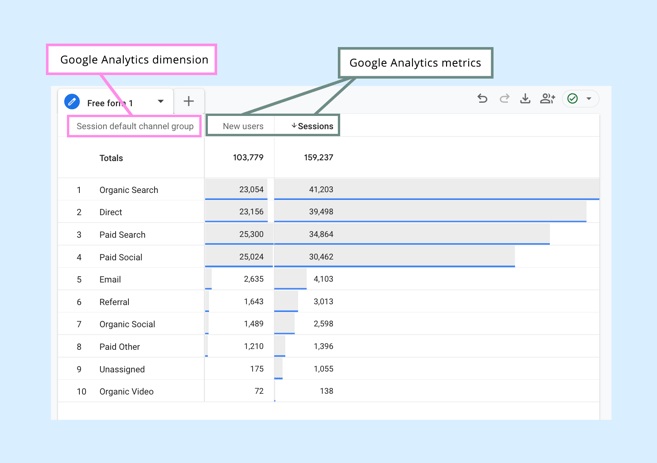Demystifying the 'Secondary Dimension' in Google Analytics: Key Insights
Demystifying the 'Secondary Dimension' in Google Analytics: Key Insights
Blog Article
Translating the Value of Secondary Dimension in Google Analytics: Everything About Its Significance and Influence
In the realm of digital analytics, the application of additional measurements within Google Analytics offers as a crucial tool for discerning deeper layers of data understandings. The relevance of secondary measurements lies in their capacity to supply a nuanced view of customer behavior and communication with a website or system.
Recognizing Secondary Dimensions in Google Analytics
The understanding of secondary dimensions in Google Analytics is essential for acquiring much deeper understandings right into customer actions and internet site performance. While primary measurements offer basic data factors such as website traffic sources and web page sights, additional measurements allow for an extra nuanced analysis by supplying additional context to these key metrics. By including secondary measurements, individuals can sector and filter their information to uncover patterns and trends that may not be quickly noticeable.

Revealing the Advantages of Additional Dimensions
Structure upon the foundational understanding of second dimensions in Google Analytics, checking out the advantages they supply exposes invaluable understandings for improving data analysis and decision-making. By including secondary dimensions, individuals can dive deeper into their data, getting a much more detailed view of individual behavior, material efficiency, and various other key metrics. Among the key benefits is the capability to segment information, enabling for an extra granular evaluation of numerous measurements such as web traffic resources, devices, demographics, and a lot more. This segmentation allows individuals to identify patterns, fads, and relationships that might not be noticeable when taking a look at information in accumulation.
Additionally, secondary dimensions provide context to key information, supplying added layers of information that can assist in understanding individual interactions and preferences. This improved understanding can guide critical decision-making, leading to more targeted advertising campaigns, website optimizations, and overall better efficiency. Essentially, second measurements offer as a powerful device for opening deeper understandings and optimizing the utility of Google Analytics for services and site owners.
Leveraging Additional Measurements for Enhanced Insights
By utilizing the power of secondary measurements in Google Analytics, organizations can discover much deeper understandings that drive notified decision-making and calculated optimization efforts. Leveraging second dimensions permits organizations to dive beyond surface-level data and obtain an extra detailed understanding of individual behavior, audience demographics, web traffic sources, and website efficiency. For example, by integrating main measurements like traffic resources with secondary dimensions such as geographical place or device classification, businesses can determine which areas or tools are driving one of the most useful traffic to their internet site.
Additionally, secondary measurements enable businesses to sector and examine data better, assisting them determine fads, patterns, and possibilities that might have or else gone undetected. By making use of additional measurements, organizations can tailor their marketing methods, web content, and individual experience to much better satisfy the needs and choices of their target audience. Basically, leveraging secondary measurements in Google Analytics equips organizations to make data-driven decisions that result in enhanced performance, increased ROI, and lasting development.

Effect of Second Dimensions on Information Evaluation
Enhancing data analysis with the utilization of secondary dimensions in Google Analytics supplies organizations with a deeper understanding of their on the internet efficiency metrics. By including secondary measurements, such as time of day, geographical location, or device classification, companies can reveal valuable understandings that may have been overlooked with primary dimensions alone. This boosted degree of granularity permits more specific segmentation of data, enabling organizations to identify patterns, trends, and correlations that can drive critical decision-making.

Making Best Use Of Potential: Secondary Dimensions Techniques
The tactical use of secondary dimensions in Google Analytics expands past enhancing information evaluation; it entails crafting targeted strategies to open the complete capacity of valuable insights for organization development. By employing second measurements successfully, organizations can dig much deeper into their web site web traffic, individual habits, and advertising and marketing projects to remove workable understandings. One vital strategy is to combine second measurements with key measurements to get a comprehensive sight of customer communications. For instance, combining the published here main measurement of 'source/medium' with additional measurements like 'touchdown web page' or 'device group' can reveal which channels are driving website traffic to particular pages or just how user habits varies throughout gadgets.
In addition, making use of secondary measurements to segment data based upon user demographics, behavior, or modern technology can aid services tailor their advertising initiatives to particular target market segments. This targeted approach can bring about improved conversion rates, improved customer experiences, and ultimately, boosted ROI. By maximizing the potential of additional dimensions in Google Analytics, businesses can make educated choices, maximize their on-line visibility, and drive lasting growth.
Verdict
In conclusion, second dimensions in Google Analytics play a crucial duty in providing deeper insights and boosting information evaluation. Including secondary measurements into information evaluation approaches can lead to even more enlightened decision-making and enhanced overall efficiency.
While primary measurements give basic data points such as website traffic resources and web page views, secondary measurements permit for a much more nuanced analysis by supplying added context to these key metrics. By you could look here incorporating primary dimensions like web traffic resources with additional measurements such as geographic area or gadget classification, services can determine which gadgets or regions are driving the most valuable web traffic to their web site.
By integrating second measurements, such as time of day, geographical place, or device category, businesses can uncover beneficial understandings that might have been neglected with main measurements alone. One essential method is to combine secondary dimensions with main dimensions to obtain a thorough sight of customer interactions. Combining the main dimension of 'source/medium' with additional measurements like 'landing web page' or 'device category' can disclose which networks are driving traffic to certain pages or how customer actions differs throughout devices.
Report this page